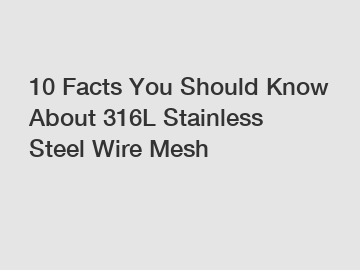The wire crimping process
The wire crimping process
Woven wire mesh (Figure 1) is a versatile industrial material produced by interconnecting strands of metal wire made from aluminum, copper, brass, bronze, mild steel, high- carbon steel, pre galvanized, titanium, or stainless steel. It is available in various styles, depending on material type, wire diameter, and opening size.
Contact us to discuss your requirements of Double Crimped Wire Mesh. Our experienced sales team can help you identify the options that best suit your needs.
Woven wire mesh is manufactured in one of two ways: plain woven or pre crimped.
Plain Woven. The wires take their shape and form during the weaving operation. Plain woven wire mesh is used for applications that require small openings, such as window screens.
Precrimped Woven. Individual wires are crimped or shaped before they are woven. Precrimped woven mesh is used to produce weaves with larger openings ' up to 8 inches. Because larger openings require greater stability, the wire must be crimped before it is woven. This stabilizes larger-scale weaves by creating a pocket where the wires intersect.
This article focuses on precrimped woven wire mesh and the importance of the crimping process in manufacturing a quality finished product.
Precrimped woven wire mesh serves an amazing array of industrial functions. It provides high functionality when used as an aggregate screen for materials companies and a unique aesthetic when used on the grilles of Rolls Royce Phantoms. It can withstand extreme temperature conditions in the heat-treating industry and resists corrosion when used in caustic environments. It protects heavy-equipment operators by serving as guard screens and is manufactured for particle-size analysis to serve as test sieve cloth.
The Crimping Process
In theory, the wire crimping process is simple: Warp and fill wires are prepped by being individually shaped so that they fit together and form tight intersections during the weaving process. But the details, which vary among manufacturers, can make or break mesh in terms of aesthetics and performance, and good fabricators instantly recognize the difference careful crimping makes in mesh quality. The consistency and repeatability provided by a precise crimping process can save fabricators time and money when precrimped wire mesh is specified.
An endless variety of metal compositions can be shaped into wire, and any metal wire can be crimped and woven. Combining the appropriate alloy with the most suitable crimp, produced with the best tooling, ensures successful industrial applications of precrimped wire mesh.
As mentioned previously, certain aspects of the crimping process vary among manufacturers. The following is one example of the process.
When a stem of wire arrives at the mesh manufacturer via a large carrier, it is placed onto an electric-assist turntable. The turntable helps ensure uniform crimp spacing as the crimping wheels pull the wire from the carrier at a consistent pace. As it gets pulled through straightening wheels (Figure 2), the wire is manipulated by the crimper (Figure 3) to produce an evenly spaced crimp with a desired specific shape.
Crimpers are so essential to wire weaving operations that they often are custom-designed by the mesh manufacturers to allow optimum control over efficiency and quality.
Crimping wheels are placed at an appropriate distance apart to create the crimp depth specified on the job sheet. Manufacturers can position wheels for crimp depth down to a thousandth of an inch. Proper crimp depth is an important variable in determining the success or failure of the weaving process. A crimp that is too deep will result in loose-woven mesh. A crimp that is too shallow will result in mesh that is too tight and very difficult to manipulate.
The more crimping wheels that a manufacturer has available, the greater variety of weaves they can create. Efficient wire mesh manufacturers produce their own crimping wheels, which allow for the constant innovation of different crimps.
Manufacturing to the Highest Standards
At the beginning of the crimping process, hand samples (Figure 4) are taken to establish that the specified crimp depths meet the application's requirements. Checking hand samples also helps ensure that quality is maintained, even throughout shift changes and multiple setup jobs. Sampling checks focus on the depth of the pocket, and recognizing the 'perfect pocket' requires careful attention. Manufacturers also must periodically check the squareness and flatness of the mesh and make sure that its spacing'or pitch'remains consistent.
The ultimate goal of the crimping process is to lay the groundwork for weaving. The loom simply finishes what the crimper starts, and the weaving process is worthless unless the crimp has been mastered.
Crimping Styles 101
Just as there are fundamental components of the crimping process, there also are fundamental styles that result from that process. When manufactured to exacting standards, the crimping styles for mesh are the basis for the material's versatility, fostering a variety of weaves that serve a multitude of industrial performance possibilities. Once again, a wider array of crimping wheels (Figure 5) expands the possibilities for crimping styles. Where an extensive range of tooling is available, the possibilities are endless.
The following crimping styles are building blocks. They can be scaled, customized, or brought together. The engineering flexibility of metal mesh opens up the possibilities for endless patterns and applications, and these crimping styles provide the foundation.
Plain. Plain crimp is a simple zigzag style of crimping, in which wires intersect at every available pocket. The smooth woven construction of plain crimp produces a subtle pattern, most common when mesh-to-diameter (MD) ratios are 4-to-1 or less. Plain crimp is suitable for many industrial applications.
Intercrimp. Intercrimp is simply a plain crimp with one small difference: wire intersections occur only at odd-numbered frequencies. The visible depressions between intersections give this crimp the appearance of being in constant zigzag motion. This widespread crimp style is most commonly used with MD ratios of 6-to-1 or greater.
Lock Crimp. Lock crimp is a more versatile crimp pattern that works well at practically any MD ratio of 4-to-1 or greater. It is characterized by straight sections of wire connected by a well-defined 'bump' at their intersections. Distinct intersections give this crimp a clean aesthetic. Appropriate for many applications, it is an ideal choice for animal confinement, heat treating, aggregate sorting, and fencing.
Flat Top. Flat top is similar to the lock crimp, but all of its crimping is offset to one side of the material. This creates a smooth top surface'with no high points'as all wires are woven on a single plane. Its bottom side, however, has crimp bumps approximately twice the height of lock crimp bumps. Flat top was originally created to allow for the smooth flow of materials over the surface and provide a flat face for use as backer screens. Flat top is ideal for aggregate sizing and sorting, agriculture, filtration, and heat-treating applications.
Triple Shoot. Triple shoot is a specialty crimp style that creates maximum open area. It consists of relatively long sections of straight wire, connected by groupings of three plain crimp pockets. The resulting material has rectangular openings with a very high aspect ratio. Used primarily for sizing and sorting applications, triple shoot screen is most effective when high flow volumes are required.
Hybrid. There are times when multiple fundamental crimp styles need to be combined into hybrid crimps to produce quality mesh that satisfies the customer's specifications.
Efficient manufacturers that carefully control every detail of the crimping process eliminate the guesswork of working with precrimped woven wire mesh. When metal mesh is manufactured to exacting standards'from the crimping to weaving'it creates cutting-edge and highly functional materials that gain competitive advantages for fabricators.
How Can I Join Stainless Steel Mesh to Create a Cylinder?
How Can I Join Stainless Steel Mesh to Create a Cylinder?
-
Thread starter
MechEng91
-
Start date
Mar 21, -
-
Tags
- Mesh Stainless steel Steel
-
In summary, the conversation discusses the need for a way to join a thin strip of stainless steel mesh to form a cylinder for use in an inline "Y" type strainer. The current method used is a heat crimp or non welding/soldering method, but the participants suggest using soldering, deep-forming a perforated sheet, or brazing as alternative methods. The main concern is maintaining the water flow through the strainer without impinging it. The participants also share links to resources for brazing stainless steel and thank each other for the suggestions.
MechEng91
- 4
- 0
Hi I need a way of joining a very thin strip of stainless steel mesh to form a cylinder.
It forms the 300 micron mesh cylinder that sits inside a inline "Y" type strainer.
The one i have currently doesn't seem to be joined by adhesive but by a heat crimp or sum sort of non welding/soldering method.
Any ideas
Cheers
- Concrete-nitrogen mix may provide major health and environment benefits
- New fabric makes urban heat islands more bearable
- Thermoelectric devices may solve overheating issues in shrinking transistors, researchers say
spanky489
- 32
- 0
i think soldering is your only shot my friend, but if you gave a better insight as to what its needed for maybe we can come up with some other method.
MechEng91
- 4
- 0
If you are looking for more details, kindly visit wholesale self cleaning mesh.
Additional reading:Why Choose Galvanized Steel Fences Over Wood?
OEM Wire Mesh Gabions vs. Traditional Stone Gabions: Which Wins?
The Benefits of Using Graco Gun Filter for Optimal Performance
Why You Should Use a Filter Ø 19mm for Your Gravity Cup: Exploring the Benefits
How to Select the Perfect Gabion Mailbox?
Key Questions to Ask When Choosing a Custom Furniture Maker
How Does Galvanized Steel Chain Link Fence Work? http://www.globalvalves.com.au/valves/STRAINER VALVES/STR-74A-Rev01.pdf
Ok the strainer is much like the one above and you can get the mesh in steel, alumin, ss etc. Its used to filter water being injected at pressure into some jets for underground coal dust suppression. We were looking to by the filter mesh with 300 micron and 100 micron filtration. It may take more to manufacture however currently we haven't sourced anything under 800 micron in filtration.
So in essence its just a throw away filter of sorts. Just need a way of forming a cylinder without soldering this very fine mesh. It shouldn't impinge the flow of water, hence no solder.
Ok the strainer is much like the one above and you can get the mesh in steel, alumin, ss etc. Its used to filter water being injected at pressure into some jets for underground coal dust suppression. We were looking to by the filter mesh with 300 micron and 100 micron filtration. It may take more to manufacture however currently we haven't sourced anything under 800 micron in filtration.So in essence its just a throw away filter of sorts. Just need a way of forming a cylinder without soldering this very fine mesh. It shouldn't impinge the flow of water, hence no solder.
Nik_
- 1,139
- 439
Unless you can deep-form a perforated sheet into a cup, you would seem to need a seam...
Given that it will be disposable, can you over-size it and close the overlap with a sandwich of welded strip metal ?
MechEng91
- 4
- 0
Nik_ said:
That is a very good idea Nik however i don't want to impinge the flow of water through the strainer. There is a seem on the one i have currently however I am not quite sure if it stuck together by adhesive but blowing air through the seam it doesn't seem to be.
That is a very good idea Nik however i don't want to impinge the flow of water through the strainer. There is a seem on the one i have currently however I am not quite sure if it stuck together by adhesive but blowing air through the seam it doesn't seem to be.
dazarooney
- 1
- 0
Nik_ said:
I had a similar question but your advice on the
I had a similar question but your advice on the perforated sheet has helped greatly.
Staff Emeritus
Science Advisor
Award
- 21,969
- 6,487
Brazing may the way to go unless one can spot weld.MechEng91 said:
http://www.abbottfurnace.com/technology/technical-papers-pdf/stainless-brazing.pdf
http://www.stainless-online.com/manufacturing/braze-stainless-tubing.htm
http://www.aws.org/wj//10/030/
Brazing may the way to go unless one can spot weld.http://www.abbottfurnace.com/technology/technical-papers-pdf/stainless-brazing.pdf
MechEng91
- 4
- 0
Thanks for the ideas guys. Been a great help
Cheers
Related to How Can I Join Stainless Steel Mesh to Create a Cylinder?
What is stainless steel mesh?
Stainless steel mesh is a type of woven wire mesh made from high-quality stainless steel. It is commonly used in various industrial and commercial applications due to its strength, durability, and resistance to corrosion.
What is the process for joining stainless steel mesh?
The process for joining stainless steel mesh typically involves welding, soldering, or crimping the individual wires together. These methods create a strong bond between the wires and ensure the mesh remains securely attached.
What type of welding is used for joining stainless steel mesh?
TIG (Tungsten Inert Gas) welding is the most commonly used method for joining stainless steel mesh. It involves using a tungsten electrode to create an arc between the electrode and the mesh, which melts the edges of the wires and fuses them together.
What are the benefits of joining stainless steel mesh?
Joining stainless steel mesh allows for the creation of custom sizes and shapes, making it suitable for a wide range of applications. It also increases the strength and durability of the mesh, making it more resistant to wear and tear.
Is it possible to join different types of stainless steel mesh together?
Yes, it is possible to join different types of stainless steel mesh together. However, it is important to ensure that the materials used are compatible and have similar melting points to avoid any issues during the joining process.
If you want to learn more, please visit our website slotted sheet metal factory.
How Does Electric Vehicle Charging Work?
The Advantages of Installing Plastic Coated Welded Wire Mesh Panel Fencing
Exploring the Titan 30 Mesh Gun Filter
ODM Prison Mesh Fencing Solutions Explained
Stainless Steel Wire vs. Galvanized Wire: What's Best for ...
Crimsafe | The Strongest Security Screens in the USA
How to Choose PVC Gabion Box ODM?









Comments
0